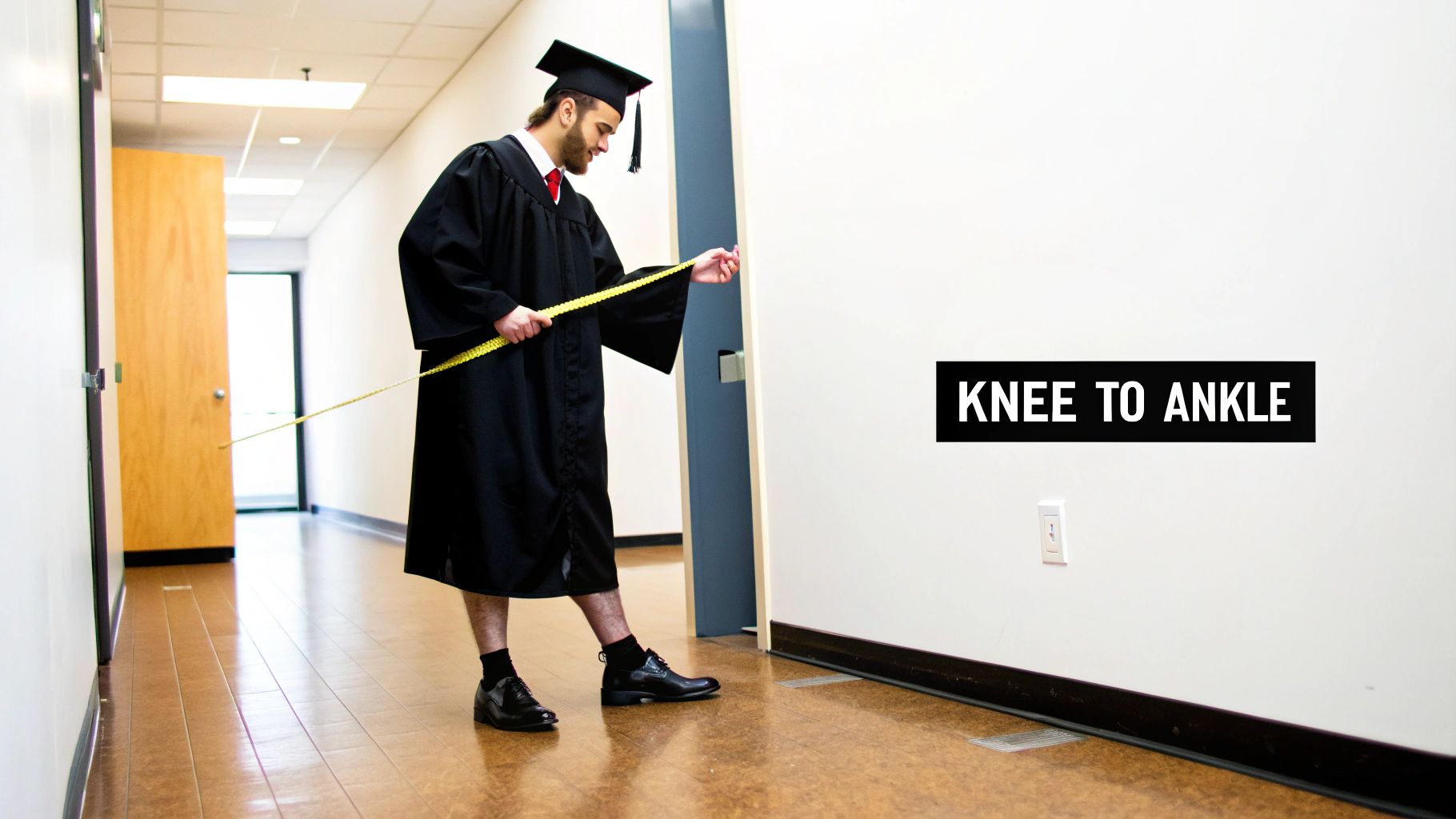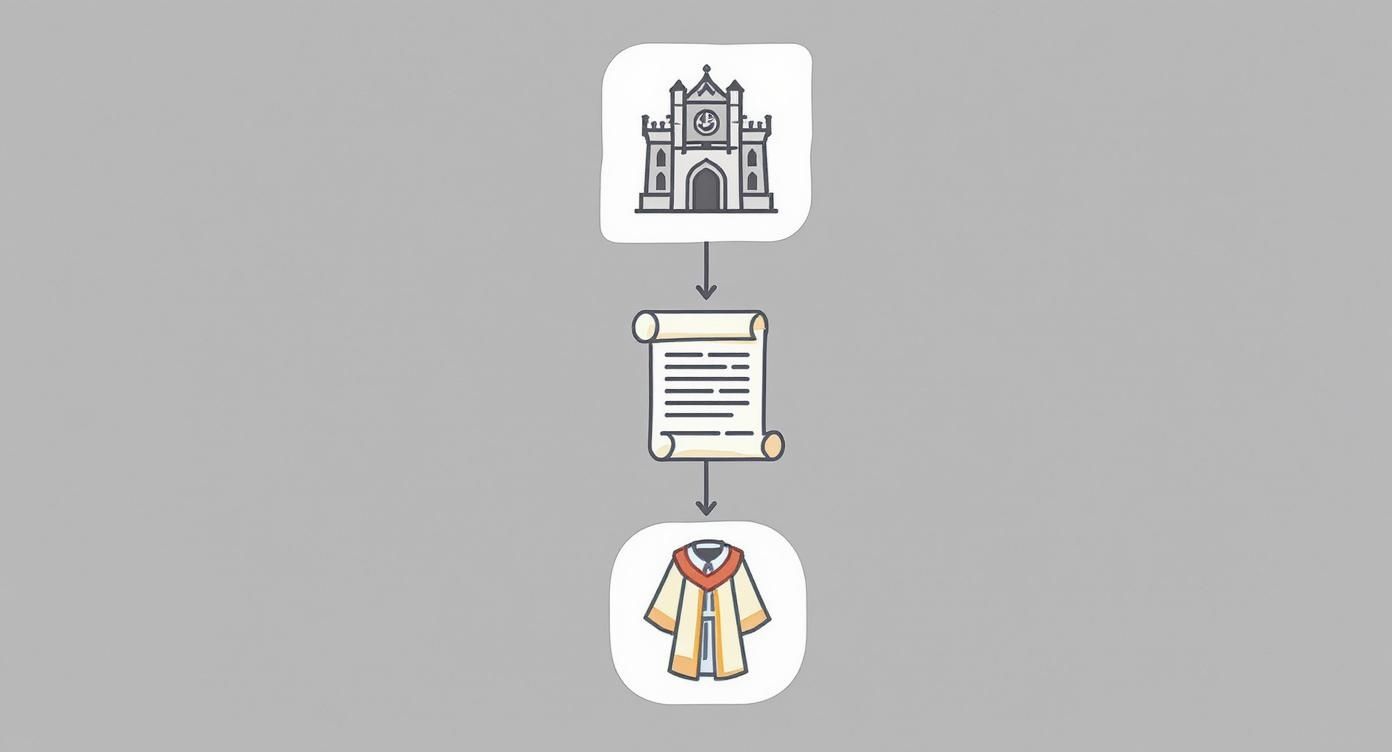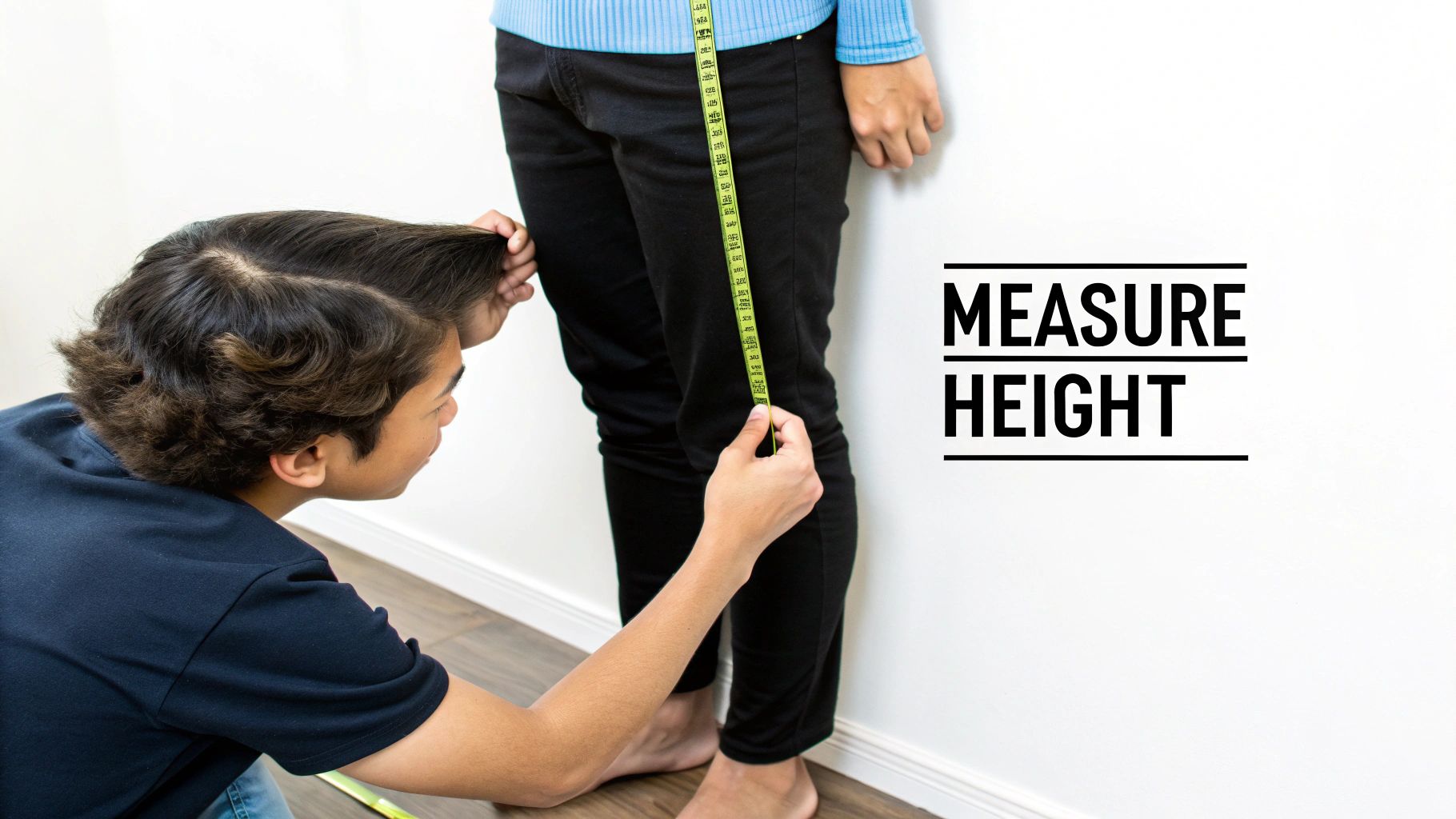The right graduation gown length is simple: it should hang somewhere between your knee and your ankle. Getting this detail right ensures you look sharp and honor the tradition of the day. Think of it like a formal coat—the length is key to a polished, dignified silhouette.

Why Your Graduation Gown Length Matters
You might not think much about the length of your gown, but it’s a small detail that makes a big difference. If your gown is too short, it can look a little goofy and casual, taking away from the formality of the ceremony. But if it's too long, you’re looking at a serious tripping hazard, especially when you’re walking up stairs to get that hard-earned diploma. Nobody wants that.
The mid-calf standard is the perfect compromise. It gives a nod to the long, flowing robes of medieval scholars while making sure you can walk across the stage with confidence. It also creates a powerful, uniform look, showing that every graduate is part of a single academic community.
For more on pulling your whole graduation look together, check out our guide on what to wear for graduation.
Finding Your Gown Size at a Glance
The good news is that you don't need to overthink it. Gown suppliers have made this incredibly easy by basing the size entirely on your total height, measured from head to toe.
Before you grab a tape measure, this quick reference chart will give you a solid idea of where you’ll land. It’s a great starting point to find your likely size in just a few seconds.
Quick Gown Size Reference by Height
| Gown Size | Recommended Height Range (Feet/Inches) | Approximate Gown Length (Inches) |
|---|---|---|
| 39 | 4'6" – 4'8" | 45" |
| 42 | 4'9" – 4'11" | 48" |
| 45 | 5'0" – 5'2" | 51" |
| 48 | 5'3" – 5'5" | 54" |
| 51 | 5'6" – 5'8" | 57" |
| 54 | 5'9" – 5'11" | 60" |
| 57 | 6'0" – 6'2" | 63" |
| 60 | 6'3" – 6'5" | 66" |
Just find your height in the middle column, and you've found your gown size. The gown’s actual length is already calculated to hit that ideal mid-calf spot perfectly.
The History Behind Academic Robes
Ever wonder why your graduation gown is so long? The design isn’t just for show; it’s a tradition that goes back more than 800 years to the cold, stone halls of the first medieval universities. In those days, scholars were often members of the clergy, and heavy, flowing robes were a practical way to stay warm during countless hours of study.
These early academic garments looked a lot like the clerical robes of the time—simple, functional, and designed for warmth. But as universities became more established, the robes took on a new meaning. They began to signify a person's status as a scholar, setting them apart from everyone else. The gown had become a uniform for higher learning.
From Practicality to Prestige
The tradition of a specific graduation gown length really took hold in the 13th century. Oxford University was instrumental in setting the standard after King Edward III granted its charter. Since most professors were clerics who wore floor-length robes, that style quickly became the norm for all academic wear. You can read more about this long history on news.umich.edu.
This direct historical connection is why the gown is still such a powerful symbol. When you wear it, you’re connecting to a long line of scholars who came before you.
Your modern ceremony is a direct link to centuries of academic heritage. The specific length and style of your gown are a nod to the scholars who wore similar robes in the great halls of Bologna, Paris, and Oxford.
Over the centuries, these practical garments evolved into the ceremonial regalia we know today. Different styles, colors, and cuts were slowly introduced to represent different levels of academic achievement. For instance:
- Sleeve Shape: Bachelor's degrees got pointed sleeves, Master's degrees got oblong sleeves, and Doctorates got full, bell-shaped sleeves.
- Hoods and Velvet: The addition of colorful hoods and velvet trim helped identify different universities and fields of study.
Every single element, from the cut of the sleeve to the length of the gown, carries a piece of this rich heritage. It’s not just a garment for a day; it's a piece of academic history you get to wear.
Decoding Gown Styles by Degree Level
While the ideal length for a graduation gown is pretty consistent, the gowns themselves are definitely not one-size-fits-all in terms of style. Think of a graduation robe as a kind of visual language—the subtle differences in design tell a story about the wearer's academic journey. The path from a Bachelor’s degree to a Doctorate is marked by increasingly detailed and distinguished regalia.
This infographic breaks down how the academic robe evolved from a practical garment for medieval scholars into the symbolic attire we wear for commencement today.

As you can see, our modern gowns, with their specific cuts and fabrics, are direct descendants of the functional robes worn centuries ago by clergy and scholars at the earliest universities.
Gown Features by Academic Degree
These visual cues are most obvious when you look at the sleeves, the material, and the overall cut of the gown. A Bachelor's gown, for instance, is the simplest of the bunch. It has pointed sleeves that signify the first degree and a straightforward design that represents the foundation of a student's higher education.
The Master's gown is where things get a bit more complex. Its most recognizable feature is the unique oblong sleeve, which is longer than the Bachelor's version and closed at the end, with a slit for your arm to pass through. This design is a clear step up, signifying a higher level of academic accomplishment.
Finally, the Doctoral gown is the most ornate of the three, a reflection of the highest achievement in academia. It boasts full, bell-shaped sleeves and is traditionally trimmed with velvet panels down the front. You'll also see three velvet bars, known as chevrons, on each sleeve. The gown itself is often fuller and made of a higher-quality fabric, giving it a more distinguished look.
These standards didn't just appear out of thin air. They were largely formalized in the 20th century, thanks to the work of the American Council on Education (ACE). In 1959, an ACE committee established clear guidelines for academic dress, including these distinct gown styles. You can learn more about this history on graduationsource.com.
To make it easier to spot the differences, here’s a quick breakdown of the features you’ll find on each type of gown.
Gown Features by Academic Degree
| Feature | Bachelor's Degree Gown | Master's Degree Gown | Doctoral Degree Gown |
|---|---|---|---|
| Sleeve Style | Pointed, open sleeves | Long, oblong sleeves with a slit for the arm | Full, bell-shaped sleeves with three velvet chevrons |
| Front Panels | Simple, unadorned front | Simple, unadorned front | Velvet panels running down the front |
| Material | Typically polyester or a simple fabric | Usually a slightly higher quality fabric than Bachelor's | Often made of high-quality material like velvet or premium fabric |
| Overall Cut | Straightforward and simple | More complex due to sleeve design | The fullest and most ornate cut |
As you can see, each gown is designed to be a clear marker of the degree earned, adding another layer of meaning and tradition to the ceremony.
Key Takeaway: The progression from a Bachelor's to a Doctoral gown is marked by increasing ornamentation. From simple pointed sleeves to full velvet panels, each element is a symbol of academic advancement, turning the gown into a wearable resume of your educational journey.
How to Measure for Your Graduation Gown
Getting the right fit for your graduation gown is simpler than you might think, and it all starts with a couple of easy measurements. While gowns are sized mainly by your height, grabbing a few key numbers ensures your regalia hangs just right, letting you focus on your big day without fussing with your outfit.
First things first: you need your total height. Kick off your shoes and stand with your back flat against a wall, keeping your head level. Have a friend place a flat object, like a book, on top of your head and make a small mark on the wall. From there, just use a flexible measuring tape to measure from the floor up to that mark. This head-to-toe number is the #1 piece of information you'll need.

Fine-Tuning Your Fit
While height gets you 90% of the way there, a couple of extra measurements can help you decide between fit options like "Regular" or "Full Fit." Taking a moment to do this ensures the gown drapes properly over your shoulders and chest instead of feeling tight or baggy.
- Chest Measurement: Wrap a tape measure around the fullest part of your chest, right under your armpits. Make sure the tape is level all the way around and snug, but not constricting. This is the key measurement for deciding if you need a "Full Fit" for extra room.
- Sleeve Measurement: Bend your elbow a little and rest your hand on your hip. Ask your helper to measure from the center of the back of your neck, across your shoulder, and down your arm to your wrist bone. This prevents the sleeves from looking awkwardly short.
Pro Tip: Always use a soft, flexible tailor's tape measure for the most accurate numbers. A rigid metal tape won't follow the curves of your body and can throw off your measurements, leading to a gown that just doesn't fit right.
If you want to get more comfortable with taking measurements for any type of clothing, this comprehensive guide on taking body measurements for clothes is a fantastic resource with techniques you can use here.
Once you have these numbers jotted down, ordering your regalia is a breeze. You'll be able to confidently find your size on any supplier's chart. For a complete rundown on all the pieces of academic regalia, check out our article on the graduation cap and gown.
Solving Common Gown Fit Problems
So you’ve measured carefully, but your gown arrives and it’s just… not quite right. Don't worry. It happens more often than you’d think, and most common fit problems have a simple, temporary fix. This is especially important for rentals, where you can't make any permanent changes.
If your gown is a little too long, it can be a real tripping hazard, especially going up and down stairs on stage. The easiest fix is to grab some fabric hem tape. It’s a no-sew adhesive you can apply to the inside of the hem to shorten it in minutes. Safety pins also work wonders in a pinch; just pin the hem up from the inside where no one will see.
What if the gown feels too short? It can end up looking a bit awkward and less formal than intended. While you can't magically add fabric, you can adjust your footwear. Choosing shoes with a lower heel or even flats can make a surprising difference, helping the gown fall closer to the intended mid-calf length for a more dignified look.
Adjusting Gown Fullness and Shoulders
Sometimes the issue isn't the graduation gown length at all, but the overall width. A gown that's too wide in the shoulders or chest can look sloppy and swallow you whole.
For a quick fix, a few strategically placed safety pins along the inside seams can cinch the extra fabric, creating a much more tailored silhouette. Another popular trick is to wear a structured blazer or jacket underneath. This helps fill out the shoulders and gives the gown a much better shape and drape.
Expert Tip: The best fix is avoiding the problem in the first place. To get your gown length and fit right without the stress of in-person fittings, you can explore services that let you try before you buy dresses online for valuable virtual try-on solutions.
With these simple adjustments, you can solve most minor fit issues in a few minutes, leaving you free to walk across that stage with total confidence.
A Few Final Questions About Gown Sizing
Even with the right measurements, you might have a couple of lingering questions about getting the perfect gown fit. Let's walk through some of the most common ones so you can feel totally confident on your big day.
We'll clear up everything from what shoes to wear to what to do if the fit isn't quite right when it arrives.
Gown Length and Footwear
One of the first things people ask is about shoes. It makes sense—your footwear choice definitely changes how your gown hangs. The key is to find a good balance between looking formal, staying comfortable, and being safe.
Your best bet is to pick comfortable shoes with a low or moderate heel. This helps keep the gown's hem from becoming a tripping hazard, landing it safely in the mid-calf area. Super high heels might make a perfectly sized gown suddenly look too short, while flats could cause it to drag, especially if you're on the shorter end of your gown's height range.
Crucial Tip: Your graduation gown should never touch the floor. Unlike historical academic robes that swept the ground, modern gowns are designed to fall somewhere between your knee and ankle. This is a huge safety feature, making it much easier to handle stairs and walk across the stage without a stumble.
Alterations and Sizing for Your Body Type
So, what happens if your gown shows up and the fit feels a little off? If you're renting, you absolutely can't make any permanent changes. Instead, grab some safety pins or fabric hem tape for a quick, temporary fix hidden on the inside seam. If you bought the gown, you could get it professionally hemmed, but honestly, exchanging it for the right size is usually the better move to keep the intended design intact.
Another common question is about how weight plays into sizing. While your height is what determines the graduation gown length, most suppliers offer a couple of different fits to accommodate different body shapes.
- Regular Fit: This is the standard cut, designed for average builds.
- Full Fit: This option gives you more room through the chest and shoulders, perfect for broader builds, without adding any extra length.
Always double-check the specific sizing charts from your supplier for the most accurate details. For a good visual breakdown, you can check out our comprehensive Stoles.com size and color charts to see how these different fits are structured. It’ll help you nail down the option that gives you both the perfect length and a comfortable fit across the shoulders.


